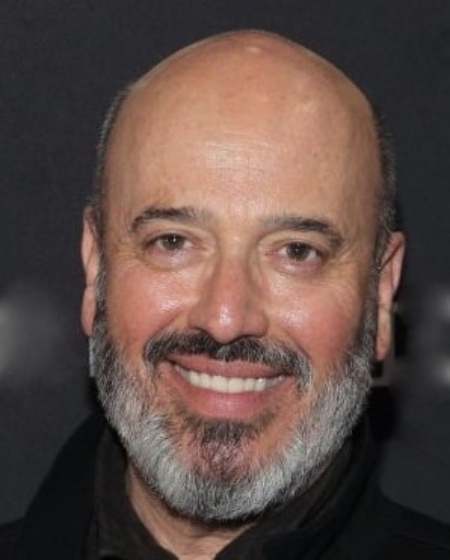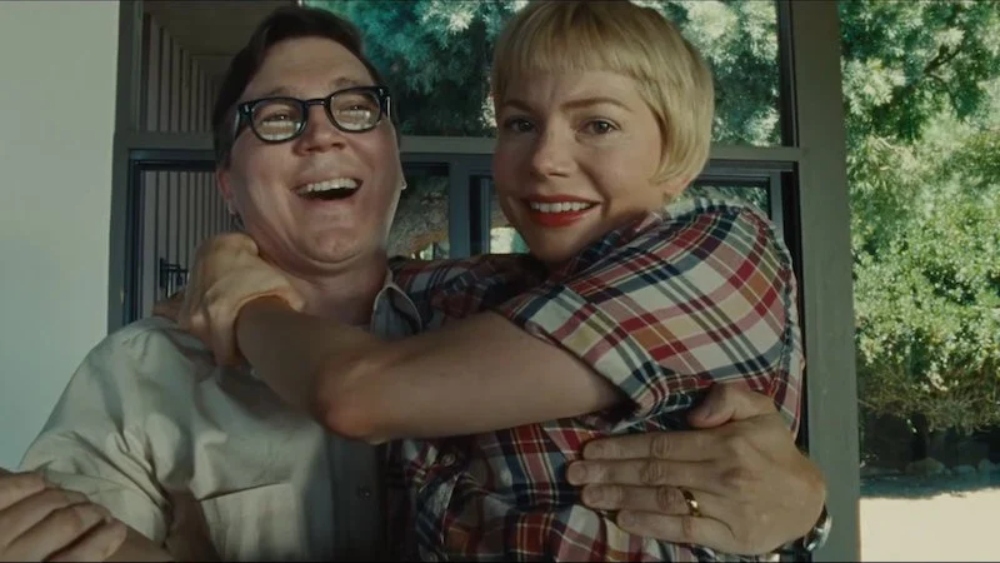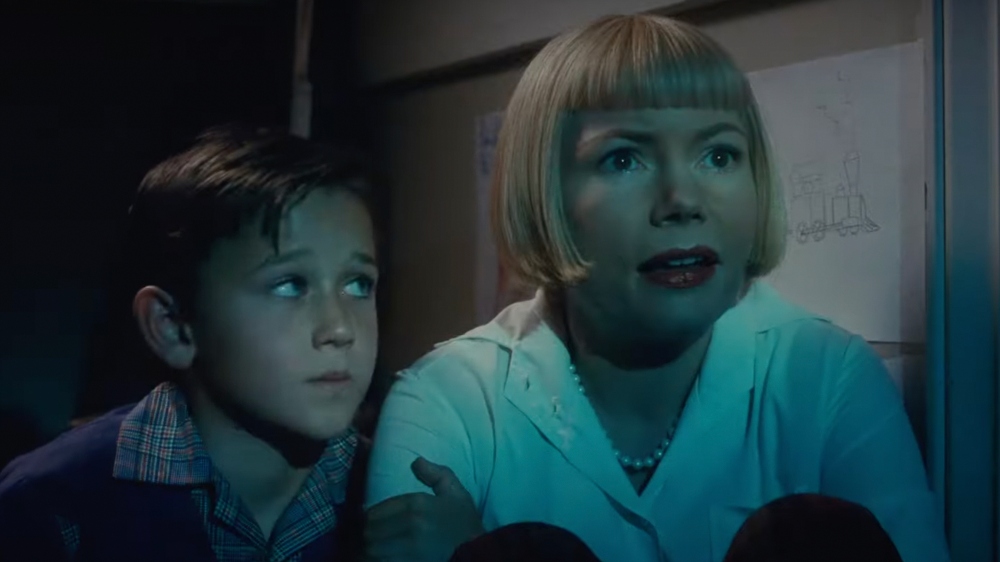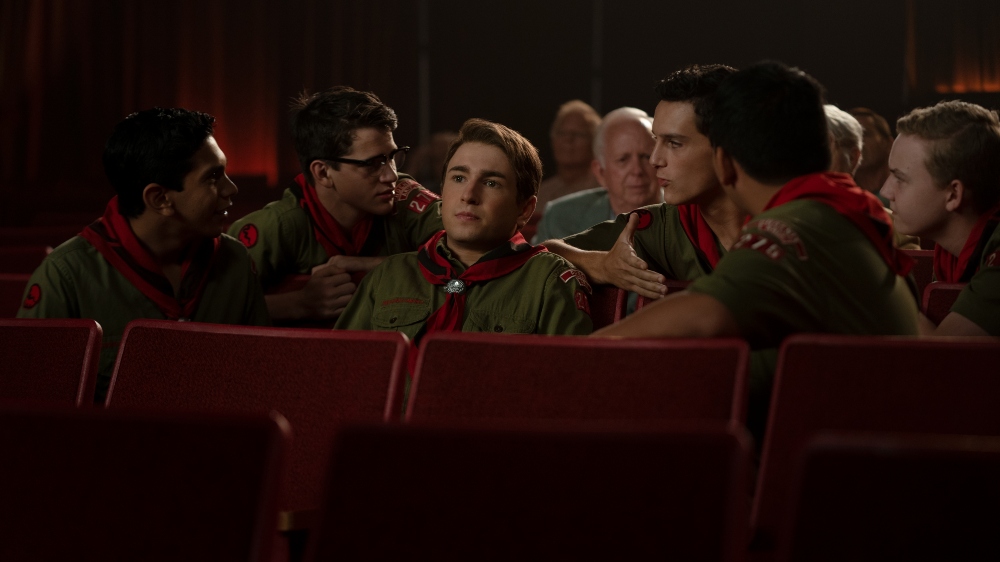In The Fabelmans, Director Steven Spielberg invites the audience to find out what shaped him, warts and all, into the famous filmmaker he is today. We meet his surrogate family, including his mother Mitzi (Michelle Williams) and his father Burt (Paul Dano), as well as his grandparents and sisters, and we see them all through a very personal lens as Spielberg’s own stand-in character, Sammy Fabelman (newcomer Gabriel LaBelle), endeavors to make movies. Sure, Spielberg and his Co-Writer Tony Kushner changed all the names, but the clothes that the fictional Fabelman family wears were very much inspired by the real Spielberg family and their varying tastes in fashion.
Costume Designer Mark Bridges, who won Oscars for his work on The Artist and Paul Thomas Anderson‘s Phantom Thread, had the delightful job of sifting through Spielberg’s family photos and home movies to find touchpoints for the central characters in The Fabelmans — and what a privilege it was! There were those magical moments when Bridges got it just right, spurring memories for Spielberg on set with certain pieces and clothing brands that his parents wore, from his mother’s lederhosen to his father’s short-sleeved dress shirt.
Below the Line recently spoke with Bridges, who was enjoying the beautiful sunshine of Los Angeles compared to the frigid temperatures of the east coast. You could hear a glow in his voice as he discussed the close relationship he developed with Spielberg throughout the course of the film while costuming his family on screen. Bridges talked about the conversations he had with Spielberg and his sisters, who also gave him insights into their mother’s choice of garments, jewelry, and even shoes, in order to help him be as accurate as possible and honor their family memories with great care and attention to detail.

Below the Line: Take me back to the beginning and your first conversation with Steven Spielberg regarding The Fabelmans.
Mark Bridges: It was, of course, over Zoom. It was right when everyone was just starting to get vaccines. One of the things that stuck out in my mind was that he mentioned that his mother had a very unique personal style. So that struck terror into my heart [laughs] and I started thinking about how we could recreate that. What is that personal style? The mind reels.
BTL: What were your first steps after hearing that?
Bridges: Doing the methodical process that I always do when I’m researching a film. Recently, I did the Leonard Bernstein biography, and you research these characters [and] see how they felt about themselves, how they dressed, what made them feel good, and what made them ready to face the world. And then you put your finger on what that throughline is. So, once I was able to access the Spielberg family photos, I spoke to [his] sisters about what they remembered their mom wearing. Then there were actually the 8mm and 16mm family films that Steven made as a child. Those were all really helpful and really helped me nail what [her] personal style was.
BTL: What did Spielberg’s sisters tell you that was sort of different than what Steven described?
Bridges: It’s the classic thing where the guy would not recognize women’s clothes, but the sisters were able to say, ‘Oh, my mother loved wearing a Lands nightgown.’ They knew brands; they knew Bernardo sandals, Lands nightgowns, and the love of the ethnic. There’s a photo of his mother wearing some lederhosen. I was like, ‘Well, I’m not exactly sure we’ll be able to fit the lederhosen in anywhere.’ She impulsively bought a pair of lederhosen at a local store that had clothing from around the world, and she also bought a smaller version for the second daughter. I said, ‘What’s with the lederhosen?’ And they gave me the background on that. They gave me insights into the fact that she made turquoise jewelry during her time in Arizona and had a specific color of turquoise that she loved. The sisters loaned me a couple of pieces of Mitzi’s jewelry, but I wasn’t actually able to use them because they were very striking and not terribly photogenic. It would distract you in a scene. But I did have access to some of the mom’s jewelry.

BTL: How did her clothing make it into some of the scenes?
Bridges: She wore one of those Mexican wedding dresses with those embroidered yoke things, and that’s why I chose to use that as the touchpoint for the dance at the campfire. Also, she wears one when they have dinner with the son’s girlfriend. You’re just finding out their personal style and cherry-picking what you want for each beat.
BTL: What about inspirations for dressing Burt Fabelman, Sammy’s father?
Bridges: There are a couple of things going on with the father. Of course, I went off of my research on Steven’s father, Arnold, and you see, there’s a throughline with him too. And I think as he went up and up, got promotions, and became more involved in developing computers and other things, I felt in my mind that he would be more like these technicians at NASA. You notice the men wearing short-sleeved dress shirts. It’s also a short-sleeved dress shirt, which is so specific to the ’60s. They do, however, reside in Arizona, [so] it made sense. There’s a balancing act between the Benny character (Seth Rogen) and the father character, like, there are subtle differences in how they dress. The father is a very straight businessman, with a necktie and a dress shirt, whereas I tried to make Benny a little more fun because that’s the dynamic in that family and what drew Mitzi to him. [He’s] just more fun, [more] comedic, and [he had] a joy of life that she found appealing and may have been one of the reasons she left the family. You just try to visually [represent] that. There are some quirky things with Arnold, like his dad’s short-sleeved shirt and bolo tie when they’re spending time in Arizona. I was just trying to be very specific, but I think mostly it was trying to illustrate the combination of his work, the progression of his work, and also the dynamics in the family.
BTL: Did Steven rifle through his own closet to give you ideas for Sammy, the character who represents him in the film?
Bridges: Steven was very helpful when we were making sure that all the Boy Scouts were accurate. We would double-check with Steven on certain things and different badges and his knowledge of the Boy Scouts because he was very involved in the Boy Scouts for many, many years. But he pretty much left me to my own devices. I worked closely with Gabriel LaBelle on the adolescent Sam, as well as the fit of the shirts and what felt right.

BTL: How did Spielberg’s home movies inspire your work?
Bridges: One of the things that were really interesting to me was that I had access to footage of Steven giving out costumes when he made the original war picture that’s [seen] in the film. He’s standing in the back of his dad’s car, like, handing out costumes to all his buddies, and, you know, they’re all getting into their khakis and grays and jeans and stuff, and Steven sort of stands out in this home movie because he is wearing, like, a red plaid shirt and probably white pants. I thought, ‘This is so perfect, I want to use it.’
BTL: Did Steven know you were going to use the clothes from his childhood films?
Bridges: I loved doing these little tricks for Steven to see on the set. Like, ‘oh my gosh, that’s what I wore.’ You see it when he’s filming all these guys out in the desert. It’s very sandy-looking and [there’s not a lot of] color, and you understand what’s in front of the camera and what’s behind the camera because Steven’s character stands out in that red plaid shirt and white trousers. It’s from reality, but it also works [visually] for me in the film and the storytelling.
BTL: It was almost like an easter egg hidden in plain sight.
Bridges: Yes, which I love to do, especially for Steven. It was so emotional for him. I remember him being really touched a couple of times when things that I had created showed up on set. He knew I was creating them, but I didn’t really tell him where I was going to put them. Michelle wears that blanket poncho at the campsite when they sing. Steven’s mother had made her own, and she put a hole in a blanket and things like that. So I remember when Michelle came to set wearing that, and Steven just tilted his head and pointed at it, and I knew that I had struck a chord with him of memory and fondness. It was really gratifying. He paused for a moment, and then he went on and did the scene, and we never spoke about it.

BTL: How lovely that must’ve been for you. In a way, would you say this is a period piece?
Bridges: I love that it’s technically a period piece. We designers are interested in contrast and things, [and] period, which is 10 or 20 years prior, but this goes back nearly 60 years to ’62 and ’63, and then definitely 70 years because it’s in the early ’50s. So it is technically a period piece, but it’s also a memory piece, so I tried to do a little of that when making choices throughout. Things pop or things are a little cleaner, and it’s kind of how your memory works a little bit. You know, Uncle Boris (Judd Hirsch) comes, and it is very early in the period; he’s coming in the ’60s, but he is wearing, like, a 1940s suit. But then when he’s giving Sam the whole story about life and art, he’s just in this white underwear, and so it’s like Sam’s memory of Uncle Boris. He knew he was in underwear, but it’s sort of bright and shiny. It’s not damaged or worn out in any way. So your memory sort of cleans things up.
And the mother is sort of the focus of attention when they all go to the scout meeting and watch the film. She’s wearing that blue dress with the white collar and kind of stands out in the group of scouts. That’s like a memory, too. It was very much about his mother’s reaction — him being mad at his mother about her going off with Benny. That part of the memory is what sticks out in that scene, and I kind of tried to do those things. You know, the use of white or the imbalance of people in the scene sometimes is because it’s what you remember, and that was something. Because it’s a memory play, that’s how I did that.
BTL: That is so fascinating. What about the inspiration for what the grandmother wore?
Bridges: You know, there are two grandmothers involved. The grandmother (Hadassah Fabelman) that Jeannie Berlin plays always seemed to have some unusually gaudy jewelry on. I thought that was kind of fun, you know, the Eastern European sense of jewelry and getting yourself together. There were photos. There were a couple of scenes that didn’t make it into the final film. I did this maroon suit, and there’s an actual photo of his grandmother in the maroon suit. Again, I was trying to strike a chord with him or recall a memory or an image of Steven. But that one didn’t make it, but we filmed it.
There were family photos, and you decide one of them seems more pattern-y and the other one seems a little more sophisticated. One seemed a little more old-country, with the floral prints and things. The other grandmother was a bit more sedate and a little more tasteful. That’s what I discovered from the family photos, and that’s how I tried to differentiate the two grandmothers.
BTL: Of all the crafts disciplines in this film, would you agree the costumes were the most personal?
Bridges: I think so. But, you know, (Production Designer) Rick Carter recreated Steven’s Arizona house from memory. I think Rick and Steven worked very closely, but certainly, the people would be the closest to a person’s memory or a feeling. I’m always on set when we establish a costume or a look, just in case something doesn’t work for any of my directors when we are going to shoot. Michelle [Williams] would go on Saturday; they’d rehearse, and then I’d hear Steven say, ‘And where’s Mark Bridges? Is Mark Bridges here?’ And I’d be like, ‘Oh boy!’ And he’d go, ‘My mother used to wear exactly that.’ I was like, ‘Oh yeah, thumbs up!’ You know, I got him that day. That he recognized his mother in what we had done was extremely gratifying. Of all things, that is probably the most rewarding thing that came out of working on this film — that I was doing justice to his family and his family’s memory, and his memory. I really wanted to do it, and I was so honored to be given that job.
The Fabelmans is now playing in theaters and available to buy or rent on all major digital/VOD platforms, courtesy of Universal Pictures and Amblin Entertainment.





